Managing household duties can be quite difficult when you have a busy work life. These days, many people depend on home services for issues like leaks, air conditioning troubles, and more.
Furthermore, these services offer a variety of options, including moving, planning parties and events, cleaning, and maintaining appliances.
Home services apps are designed to meet users' demands for various household tasks. With a single click, you can hire professionals to manage your home tasks.
If you have a home service business, then developing a home service app is the best approach to expand your business. It will not only bring more but will also multiply your profits.
With apps like Urban Company and Task Rabbit becoming more popular day by day, it's high time to explore the home service market with a robust app.
Our complete guide to home service app development will walk you through the different aspects of this industry to gain a better understanding of the process. Let's start with studying the market statistics to check the scope of new possibilities.
Home Service App Market At Glance
The home service market is thriving with the support of increasing digitalisation, urbanization, and convenience-seeking consumers.
Before moving further in this home service app development guide, here are the latest insights, showcasing the significant growth and the competitive nature of the home service market.
-
- The size of the worldwide online on-demand home services market was valued at USD 3.71 billion in 2021 and is projected to grow at a CAGR of 16.7% between 2022 and 2030.
- The U.S. home service market is projected to reach $170.87 billion by 2032, growing at a CAGR of 7.2% from 2024-2032
- According to industry reports, there has been a significant rise in online bookings for home services, with around 70% of customers opting to book services online and a 52% increase in online bookings between 2019 and 2022.
- Consumer trends show 62% of home service customers initiate a call during their purchasing journey, highlighting the importance of multi-channel accessibility.
- In the U.S., a notable portion of homes are older, with almost 40% being more than 50 years old, leading to higher demand for services such as plumbing, electrical work, roofing, and structural repairs.
- 80% of buyers consider review sites useful during their search. Home service providers must go beyond standard review platforms such as Google My Business and make sure their reputations are pristine on home service review sites like Angi.
What is a Home Service App?
Home service apps are online platforms that connect people with qualified experts providing a variety of on-demand services. These services generally cover home maintenance, cleaning, plumbing, electrical repairs, landscaping, pest management, and additional tasks.
Designed to ease the search for skilled service providers, these applications allow users to schedule, book, and pay for services straight from their smartphones.
Home service apps have revolutionized how people meet their household requirements by connecting customers with service professionals, providing convenience, transparency, and efficiency.
With the increase in use of internet services and smartphones, these apps have become a part of people's lives in urban areas where time limitations often make it difficult to manage the household chores.
Home services apps have features like real-time tracking, secure payments, and customer reviews, which help the users make informed decisions, ensuring service quality.
Types of Home Service Apps
To develop a home service app, it is necessary to understand its types. It mainly offers various household and lifestyle-related services, simply based on the user's demands and also helps businesses connect with their target audience directly.
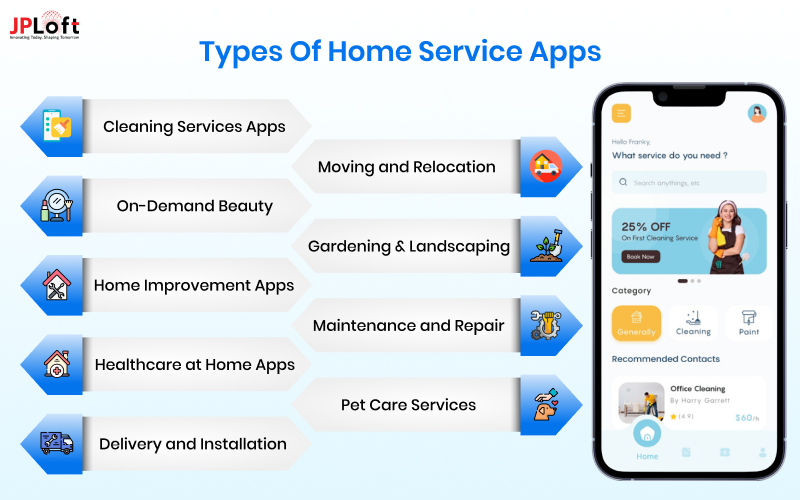
Below is a detailed overview of the major types of home service apps, their key features, and examples.
1. Cleaning Services Apps
These apps help users book professional cleaning services for their homes or offices. It generally offers deep cleaning, regular upkeep, carpet cleaning, and pest control services.
Key Features:
-
- Flexible scheduling options.
- Real-time tracking of cleaners.
- Eco-friendly cleaning options.
Example: Handy offers a wide range of cleaning and repair services with transparent pricing and vetted professionals.
2. On-Demand Beauty Services Apps
Beauty service apps allow users to book salon or spa treatments from the comfort of their homes. These services often include hairstyling, manicures, facials, and massages.
Key Features:
-
- Customizable service packages.
- Trained and certified beauticians.
- In-app consultation for personalized care.
Example: UrbanClap (Urban Company) is a leader in on-demand beauty and wellness services, offering everything from hairstyling to Ayurvedic treatments at home.
3. Home Improvement Apps
These apps help in home remodeling, interior design, painting, and other improvement projects. They often connect users with designers, architects, and skilled workers.
Key Features:
-
- Virtual consultations and design previews.
- Cost estimation tools.
- Material procurement assistance.
Example: Houzz combines inspiration with access to home improvement professionals, enabling users to execute their dream projects seamlessly.
4. Healthcare at Home Apps
These apps cater to medical and wellness needs, providing services like nursing care, physiotherapy, elder care, and teleconsultations.
Key Features:
-
- Certified medical staff.
- Integration with wearable health devices for monitoring.
- Secure telemedicine consultations.
Example: Practo connects users to doctors and healthcare professionals, offering both virtual and in-home care options.
5. Delivery and Installation Services Apps
These apps assist users in assembling furniture, installing appliances, or delivering heavy items like electronics and furniture.
Key Features:
-
- Step-by-step updates on installation or delivery.
- Assistance with warranty or after-service care.
- Ratings and reviews for technicians.
Example: Thumbtack is a versatile platform offering services like appliance installation, furniture assembly, and more.
6. Moving and Relocation Apps
These applications streamline the process of relocating homes or workplaces, offering services such as packing, transportation, and unpacking.
Key Features:
-
- Real-time tracking of moving trucks.
- Cost calculators based on volume and distance.
- Assistance with furniture assembly post-move.
Example: MoveEasy is a user-friendly platform offering moving services tailored to customer needs.
7. Gardening and Landscaping Apps
Focused on outdoor spaces, these apps provide services like lawn care, landscaping, tree trimming, and seasonal maintenance.
Key Features:
-
- Automated scheduling for recurring tasks.
- Integration with weather data for optimal service planning.
- Virtual consultations for landscaping ideas.
Example: LawnStarter enables users to book professional lawn care services with ease, including regular mowing and seasonal maintenance.
8. Maintenance and Repair Apps
These apps are focused on resolving common household issues, helping users to connect with skilled technicians for tasks like plumbing, electrical repairs, HVAC servicing, and appliance maintenance.
Key Features:
-
- Service tracking and real-time updates.
- Emergency repair options.
- Reviews and ratings for service professionals.
Example: TaskRabbit provides quick access to handymen for home repairs and maintenance tasks, often on short notice.
9. Pet Care Services Apps
Pet lovers can use these apps to book grooming, pet-sitting, dog-walking, or veterinary services.
Key Features:
-
- Emergency veterinary support.
- GPS tracking for pet walkers.
- Photo updates of pets during services.
Example: Rover focuses on linking users with reliable pet sitters and walkers, ensuring excellent care for pets.
How Do Home Service Apps Work?
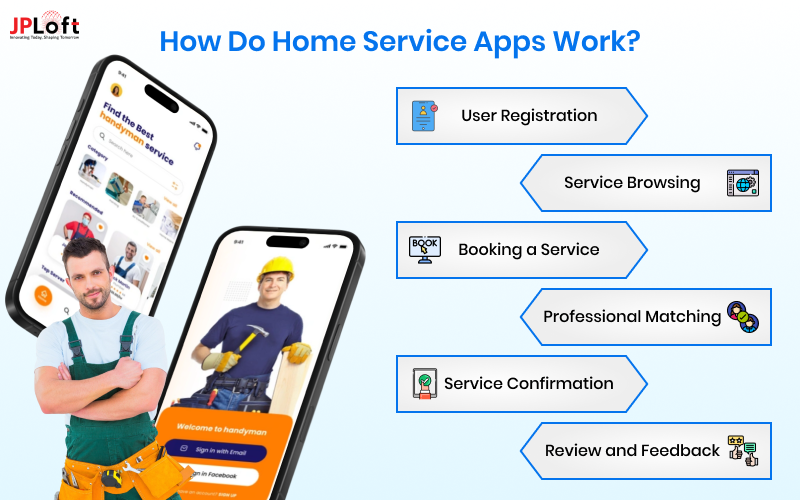
Home service apps operate on a straightforward workflow that ensures convenience for both users and service providers:
-
- User Registration and Profile Setup: Customers sign up on the app and create profiles, providing essential details like location and service preferences.
- Service Browsing: Users browse or search for specific services using intuitive categories or search bars. Advanced apps offer filters to refine searches by price, rating, or proximity.
- Booking a Service: After selecting a service, users can choose a convenient time slot and confirm their booking. Many apps also allow real-time availability checks of professionals.
- Professional Matching: The app’s algorithm matches the user with an available and qualified service provider based on factors like location, ratings, and expertise.
- Service Confirmation and Payment: Once matched, users receive details about the service provider. After the service is completed, payment can be made directly through the app via integrated payment gateways.
- Review and Feedback: Customers can rate and review the professional’s performance, helping maintain service standards and transparency within the app ecosystem.
Moving forward in the home service app development guide, we are now going to draw inspiration from these market-leading apps.
Best Home Service Apps
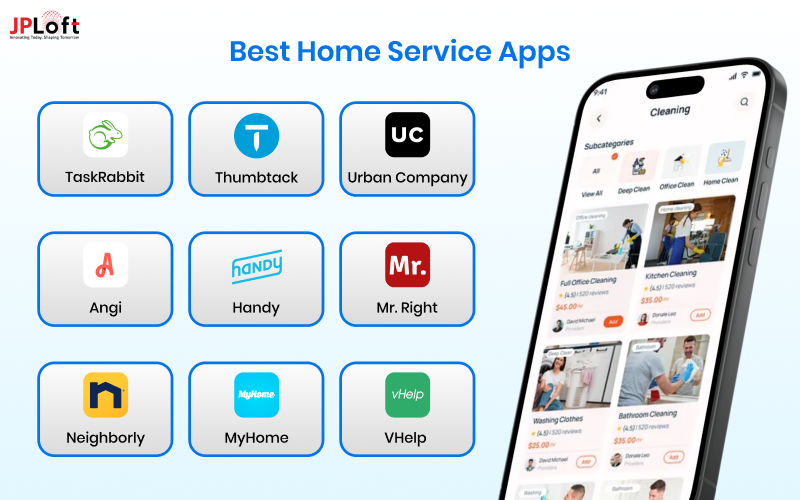
These are the 10 top home service apps that provide a mix of convenience, dependability, and easy-to-use functionalities to efficiently handle home chores.
To understand how to create a home service app, it is important to understand these successful platforms.
|
App Name |
Unique Features |
Downloads |
|
TaskRabbit |
Flexible pricing, trusted professionals, wide range of services (e.g., furniture assembly, repairs). |
5M+ |
|
Thumbtack |
Personalized service suggestions, cost estimates, and unique services like photography and personal coaching. |
1M+ |
|
Urban Company |
Professional at-home services (beauty, cleaning, repairs), subscription-based plans for regular services. |
10M+ |
|
Angi |
User reviews for professionals, wide range of services, and local contractor connections. |
5M+ |
|
Handy |
Transparent pricing, vetted professionals, scheduling flexibility. |
1M+ |
|
Mr. Right |
Wide range of home services, reliable professionals, and transparent pricing. |
1M+ |
|
Neighborly |
Focuses on community-supported services with streamlined professional connections. |
10K+ |
|
MyHome |
On-demand home services with a focus on cleaning, repairs, and interior design, integrated with smart home technology. |
100K+ |
|
VHelp |
Simplifies household task bookings with reliable providers for various home needs. |
1K+ |
Core Home Service App Features You Can't Miss
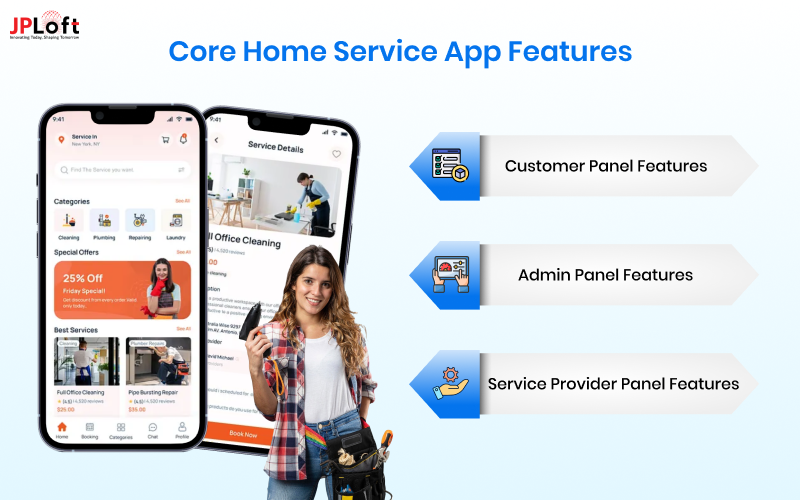
When you're planning to create a home service app, it's important to incorporate these essential features to enhance user experience and ensure your app's success:
► Customer Panel Features
-
- User Registration & Profile Management: Easy sign-up and profile creation to track booking history and preferences.
- Service Browsing & Booking: Explore available services and make bookings with an intuitive interface.
- In-app Payments: Secure payment options like credit cards, wallets, and UPI integrations.
- Real-time Tracking: Monitor service progress and estimated arrival times.
- Reviews & Ratings: Provide feedback to improve quality and assist other users.
► Admin Panel Features
-
- User & Provider Management: Oversee customer and service provider registrations, ensuring proper onboarding.
- Service Management: Add, modify, or remove services based on demand or seasonal trends.
- Analytics Dashboard: Gain insights into revenue, user behavior, and service performance for strategic decisions.
- Payment Management: Manage transactions, commissions, and refunds efficiently.
- Dispute Resolution System: Address and resolve complaints or service issues quickly.
► Service Provider Panel Features
-
- Profile Management: Create and edit profiles with skills, availability, and rates.
- Job Notifications: Receive alerts for new service requests in real time.
- Earnings Dashboard: Track income, completed jobs, and pending payments.
- Service Scheduling: Accept or decline requests based on availability.
- Location Tracking: Utilize geolocation for seamless navigation to the customer’s location.
Including these core features when you build a home service app will give you a competitive edge and improve the overall user experience.
Why Should You Develop A Home Service App?
If you're wondering whether to build a home service app, here are major reasons that can guide your decision:
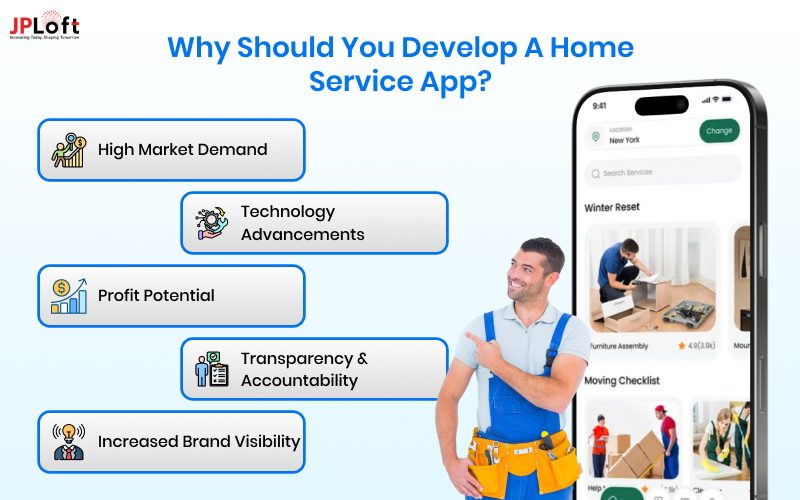
1] High Market Demand
As the worldwide home service sector expands quickly, there is a rising need for on-demand services such as cleaning, repairs, and personal help. As people seek convenience, the need for easy access to reliable professionals is greater than it has ever been.
2] Technology Advancements
Ongoing enhancements in application development technologies may allow you to design a home service app that is more effective, safe, and easy to use.
Now is an excellent opportunity to utilize emerging technologies such as AI and real-time tracking to deliver outstanding service to your users.
3] Profit Potential
The home service industry is profitable, with many businesses achieving significant success by providing convenience via technology.
Whether through one-time services or subscription plans, there are numerous methods to generate revenue from your app, making it a wise investment.
4] Transparency and Accountability
Before scheduling services, users may read other people's reviews and ratings on most home service apps, which are based on user activity and market growth.
This encourages accountability and openness, enabling clients to choose reputable service providers and make informed decisions, all of which result in increased revenue and brand exposure.
5] Increased Brand Visibility
The home service app will enhance your brand's exposure and help in brand development. Considering that over 29% of consumers use their mobile devices weekly, your business needs to attract the audience's attention.
A greater online presence will enhance your chances of outdoing your competitors. To ensure your users are satisfied, you need to provide updates promptly.
If you're set to build a home service app, the market environment is promising. Creating a home service app enables you to take advantage of the increasing need for convenience and efficiency while establishing a sustainable business.
Step-by-Step Guide to Home Service App Development
Developing a home service application requires proper preparation, thoughtful decision-making, and specialized technical skills.
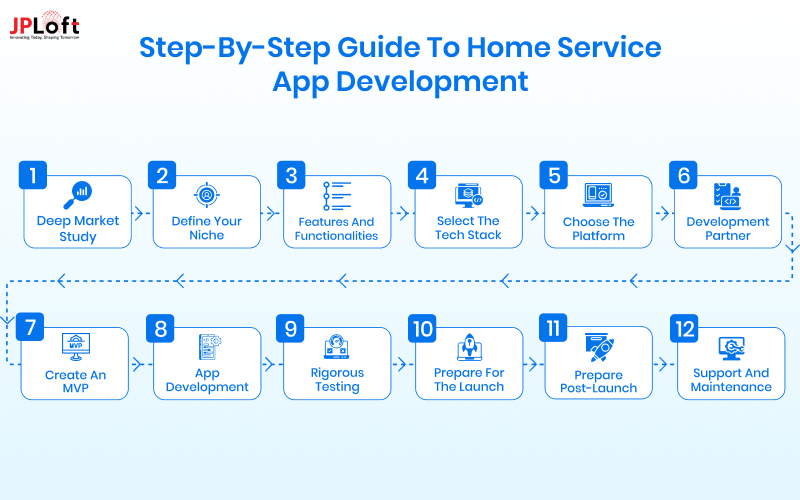
Here is a complete home service app development guide, covering everything from the initial market research to ongoing support and maintenance after launch.
Step 1: Deep Market Study
The initial stage in how to develop a home service app is performing an in-depth market analysis. This includes understanding the existing trends, recognizing user challenges, and assessing the competitors. By examining what comparable applications in the market are, you can identify chances to provide something distinctive.
Market research helps in identifying your target audience's needs, preferences, and the obstacles they face. Using this information, your app can address a well-defined market segment, establishing the groundwork for a solution that users truly desire.
Step 2: Define Your Niche
After analysing the market, it's time to pinpoint your niche. The home service sector is extensive, including offerings such as cleaning, plumbing, childcare, and beyond. Determining if your app will provide various services or focus on a single area is essential.
For example, an application dedicated exclusively to pet care can cater to a particular audience, whereas a more general app may attract a wider market. Establishing a specific niche allows your app to differentiate itself and aids in creating a brand identity aimed at a certain audience.
Step 3: Decide The Features and Functionalities
Determining the features and functionalities is another essential step. Features such as service booking, in-app transactions, and client feedback are crucial. Advanced features, like AI-powered service suggestions and live GPS tracking, can further improve the user experience.
Prioritizing features according to the needs and budget limitations of your target audience is essential. Thorough research about functionalities at this point ensures that the development team comprehends the scope and requirements.
Step 4: Select The Tech Stack
Choosing the appropriate technology stack is just as crucial. The selection of technologies affects your app's performance, scalability, and maintenance simplicity. For example, employing frameworks such as React Native or Flutter enables you to create a cross-platform application that operates smoothly on both iOS and Android.
In the meantime, strong back-end technologies like Node.js and Firebase guarantee that your app efficiently manages user requests. An appropriately selected tech stack not only facilitates present features but also allows for future improvements.
Step 5: Choose the Target Platform
Choosing the target platform is the vital step. Deciding to launch on iOS, Android, or either platform relies on your target audience and financial resources. Android is well-suited for connecting with a wider global audience, whereas iOS is typically favored for greater user interaction and revenue opportunities.
If you want to access both platforms without increasing your mobile app development cost, utilizing cross-platform development with frameworks such as Flutter is an economical choice.
Step 6: Find a Reliable Development Partner
Finding an expert on-demand app development company is a critical choice in the process. Regardless of whether you opt for an in-house team, a freelancer, or an agency, the chosen team must have the required expertise in developing home service apps.
Evaluating their portfolio, client feedback, and communication abilities can assist you in finding the ideal partner. An effective development team transforms your concept into reality while sticking to schedules and financial plans.
Step 7: Create an MVP
Building a Minimum Viable Product (MVP) begins with app wireframes and prototypes - the most effective approach to evaluating your concept in the actual market. An MVP contains just the essential features, including service listings, booking systems, and a simple payment gateway.
By starting with an MVP, you obtain important user insights without significantly investing in a fully finished application. This input helps refine developments and reduces the chance of creating features that fail to connect with your audience.
Step 8: App Development
Once the MVP has been confirmed and improved based on initial feedback, continue to full-scale app development. It is one of the longest and most complex step in complete home service app development guide that needs careful consideration
Focus on adding abilities like personalization, analytics, advanced payment systems, and any unique features that match with your home service app idea. Collaborate with a skilled development team to ensure growth, security, and compliance with industry standards.
Step 9: Rigorous Testing
A thorough testing period is necessary before the launch. Thorough app testing makes sure that the application is free of bugs, secure, and easy to use.
Conduct functional testing to confirm features, usability testing to assess user satisfaction, and performance testing to validate the app's capacity for high traffic.
Practical testing in various settings further confirms the app's readiness to work in different environments.
Step 10: Prepare for the Launch of the App
The official release of your application is an exhilarating milestone. Nonetheless, an effective launch requires effective planning.
Whether you publish your app on play store or submit it on app store, it requires adhering to their guidelines, crafting an appealing app store listing, and optimizing keywords to improve visibility.
Marketing prior to launch via social media, collaborations, and email campaigns can create excitement and ensure a solid beginning.
Step 11: Prepare Post-Launch Strategy
The success after launch relies on a strong strategy. Consistent updates that add new features and fix issues show users that your app is progressing to fulfill their requirements.
Ongoing marketing strategies, including promotions, social media campaigns, and partnerships with influencers, maintain user engagement. Interacting with your audience via support channels and gathering feedback enhances user satisfaction and retention even more.
Step 12: Support And Maintenance
Ultimately, support and maintenance guarantee that your app stays operational and relevant. Consistent performance evaluation, adherence to platform upgrades, and technical assistance ensure the app operates effectively.
App maintenance services involves more than just resolving problems—it includes adjusting to user needs and market developments, keeping your app relevant in a swiftly changing industry.
Latest Trends in Home Service App Development
The latest trends in home service app development reflect the growing influence of advanced technologies and shifting consumer priorities. These include:
-
- AI Integration for Personalization: AI-powered algorithms are being used to deliver personalized recommendations based on user preferences and past behaviors. This enhances the customer experience and boosts engagement by suggesting tailored services.
- IoT for Smart Homes: The Internet of Things (IoT) is enabling seamless integration with smart home devices. For example, users can schedule and control services like cleaning or maintenance directly through IoT-connected apps, enhancing convenience and efficiency.
- Eco-Friendly Solutions: Consumers are increasingly drawn to apps offering sustainable service options, such as green cleaning services or eco-conscious repair solutions. These apps align with global sustainability trends and regulations.
- Blockchain for Security: Blockchain technology is revolutionizing secure transactions in home service apps. It provides decentralized and tamper-proof payment solutions, ensuring trust and transparency in monetary exchanges.
- Super Apps: Apps combining multiple services into a single platform are gaining traction. This "one-stop solution" model allows users to access diverse services, from plumbing to lawn care, within a unified interface.
- Augmented and Virtual Reality (AR/VR): AR and VR are being adopted for virtual consultations, allowing users to visualize service outcomes, such as interior designs, before committing to a purchase.
These trends indicate a strong movement towards enhancing user experiences with intelligent, secure, and sustainable solutions in home service industry. Staying ahead in this competitive field requires incorporating these innovations strategically.
Cost to Build a Home Service App
The cost of developing a home service app typically ranges from $30,000 to $150,000 or more, depending on several factors. Basic apps with essential features might cost on the lower end, while advanced apps with custom functionalities, multiple integrations, and scalability requirements fall on the higher end.
For precise cost estimates, factors like the app’s complexity, development region, and technology stack play a significant role. Below is a table highlighting the key factors affecting the app development cost:
|
Factors |
Effect on Cost |
|
App Complexity |
Basic apps are less expensive, while complex apps with advanced features like AI or AR cost more. |
|
Number of Features |
More features lead to higher development costs due to increased coding and testing requirements. |
|
Development Platform |
Developing for iOS, Android, or both affects the budget. Cross-platform apps are cost-efficient. |
|
UI/UX Design |
Custom, intuitive designs require additional design expertise, increasing costs. |
|
Development Team |
Hiring a skilled app development company ensures quality but can be pricier. |
|
Tech Stack |
Advanced technologies like React Native or Node.js affect costs based on performance needs. |
|
Geographic Location |
Developers in regions like the U.S. charge more compared to Asia or Eastern Europe. |
|
Post-Launch Support |
Ongoing maintenance and updates add to the long-term cost. |
If you're considering how to develop a home service app on a budget, opting for an MVP and hiring app developers from a reliable company can significantly optimize costs.
How to Monetize a Home Service App?
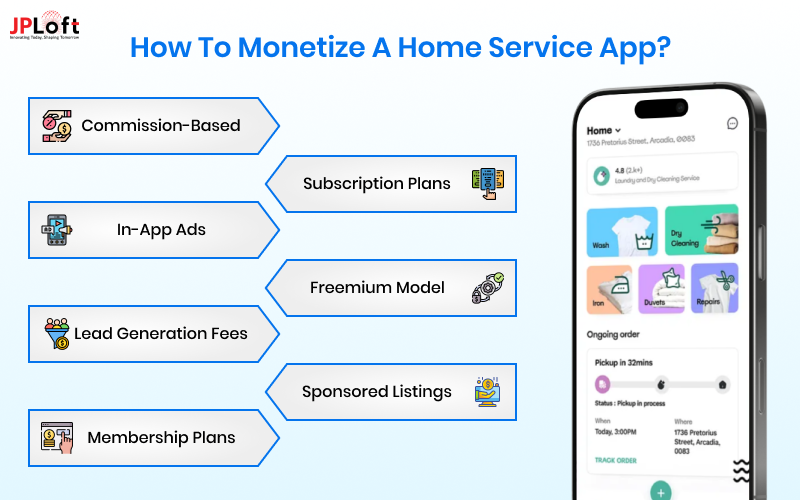
Monetizing your app effectively requires a deep understanding of your target audience and the value you’re delivering. It involves strategic approaches to ensure steady revenue while providing a better experience to users and service providers.
Here are some common monetization strategies for such apps:
-
- Commission-Based Model: Charge service providers a percentage or flat fee for each booking made through the app. This model ensures a steady income stream as the app scales with more users.
- Subscription Plans: Offer subscription tiers for service providers to unlock premium features like enhanced visibility or priority listing. Customers can also subscribe to monthly or yearly plans for exclusive discounts or priority services.
- In-App Advertisements: Collaborate with relevant brands to display ads in the app. Ads can be non-intrusive banners or tailored suggestions for users based on their preferences. This method works best for apps with a high user base.
- Freemium Model: Provide basic services for free and charge for advanced features or premium services. For instance, users can book regular services for free but pay extra for urgent or elite services.
- Lead Generation Fees: Charge service providers for each lead or inquiry generated through the app. This model benefits providers by connecting them directly with potential customers.
- Sponsored Listings: Allow service providers to pay for premium placement in search results or highlight their services, increasing visibility and attracting more bookings.
- Membership Plans: Offer customers exclusive membership plans with perks like waived service charges, cashback offers, or priority customer support.
How to Overcome The Challenges of Home Service App Development
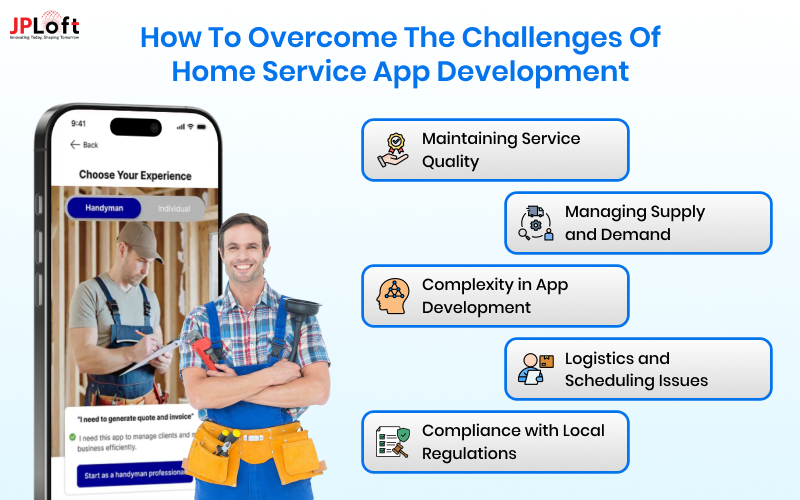
Building a home service app comes with unique challenges specific to the industry, but addressing them effectively ensures success. Below are the major challenges and their practical solutions:
► Maintaining Service Quality and Reliability
Challenge: Maintaining consistent quality among different service providers can be challenging because of differences in expertise, experience, and customer interaction. Unreliable providers can damage the app's reputation through negative reviews.
Solution: Create a thorough evaluation procedure during onboarding to confirm the qualifications and background of service providers.
Consistently gather user feedback and evaluations to assess performance. Moreover, implement a real-time support system to swiftly address and resolve disputes.
► Managing Supply and Demand
Challenge: Managing the number of service providers and user requests can be difficult, particularly during busy periods. A lack of providers may cause unoccupied bookings, whereas an excess can lead to service professionals being idle without work.
Solution: Utilize data analysis to predict demand patterns and adjust provider onboarding efforts as needed. Encourage providers by offering flexible schedules and increased rates during busy periods to ensure sufficient availability.
► Complexity in App Development
Challenge: Developing a scalable, feature-packed app demands careful planning and expertise in app development. Achieving smooth integration of payment gateways, GPS, and instant notifications can be difficult.
Solution: Collaborate with a company that offers a wide range of mobile app development services to create on-demand applications. They can assist you in developing a home service app that is easy to use and adaptable.
► Logistics and Scheduling Issues
Challenge: Handling real-time reservations and cancellations while reducing service delays can be difficult.
Solution: Implement advanced scheduling algorithms to enhance bookings and include buffer periods between appointments. Use in-app tracking and alerts to keep users updated on their booking status.
► Compliance with Local Regulations
Challenge: Various regions follow distinct labor regulations and licensing prerequisites for service providers, which may complicate operations.
Solution: Approach legal professionals to ensure compliance with local laws and regulations. Consistently review procedures to conform to evolving legal environments.
By tackling these challenges in advance, you can make a home service application that fulfills customer needs while remaining competitive. Following this guide helps you overcome these challenges effectively, building a strong and dependable platform for both users and service providers.
Key Metrics to Measure Success of a Home Service App
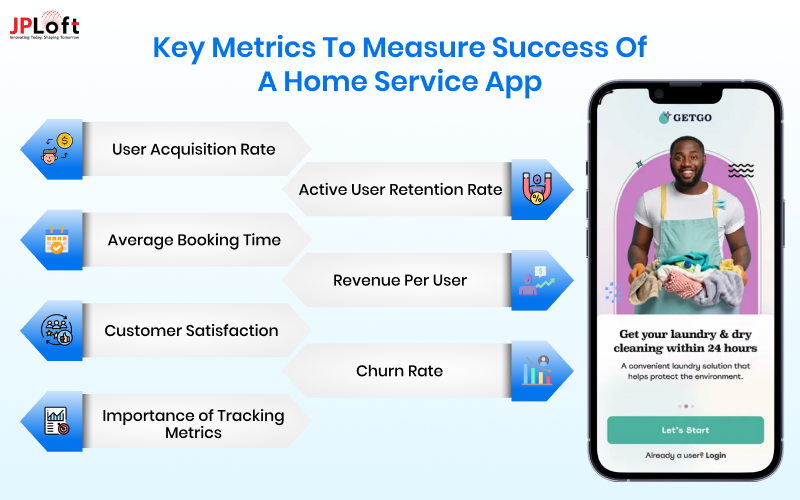
Now that you know all about how to build a home service app, it's time to learn about post-launch steps.
Measuring the success of a home service app post-launch is critical for optimizing performance and ensuring business growth.
By tracking the right metrics, decision-makers can identify areas of improvement and calculate ROI effectively. Here are the key performance indicators (KPIs) to focus on:
A] User Acquisition Rate
This metric measures how effectively the app attracts new users. High acquisition rates indicate successful marketing strategies and app appeal.
Tracking sources like organic downloads, paid campaigns, and referrals can help optimize user growth. To develop a home service app that sustains growth, this metric is vital for early-stage evaluations.
B] Active User Retention Rate
Retention rate shows how many users continue using your app over time. Apps with strong retention typically provide exceptional value, seamless user experience, and timely updates.
Retention strategies like push notifications, loyalty programs, and regular service enhancements are key to building a home service app that keeps users engaged long-term.
C] Average Booking Time and Frequency
This metric highlights how often and how quickly users complete service bookings. Faster booking times and higher frequencies often indicate an intuitive interface and high user satisfaction.
Optimize booking flows to reduce friction and make a home service app that prioritizes convenience for users.
D] Revenue Per User (RPU)
Revenue per user determines the average earnings generated from each user over a specific period. It is essential to track revenue sources, including subscription fees, commissions, or in-app advertisements.
For businesses wondering how to create a home service app with high profitability, RPU provides a clear financial lens.
E] Customer Satisfaction Score (CSAT)
Gathering feedback from users post-service ensures you meet customer expectations.
High CSAT ratings often correlate with positive reviews, better app ratings, and repeat bookings. Including surveys or satisfaction tracking features in your home service app can enhance user trust and loyalty.
F] Churn Rate
This measures the percentage of users who stop using the app over time. A high churn rate suggests issues with user experience or value delivery. Addressing churn requires analyzing exit feedback and implementing continuous improvements.
G] Importance of Tracking Metrics
To create a home service app that thrives, continuous monitoring and optimization of these KPIs are crucial.
Leveraging these metrics as part of your home service app development process ensures a data-driven approach, helping businesses make informed decisions and maximize their investment.
By focusing on these measurable outcomes, businesses can ensure their home service app aligns with user needs and industry expectations, building a strong foundation for long-term success.
Build A Feature-Rich Home Service App With JPLoft
Transform your business with a cutting-edge home service app! At JPLoft, we specialize in creating innovative, user-friendly solutions tailored to your needs.
Whether you want to simplify booking processes, boost customer retention, or streamline service management, we have the expertise to deliver.
As a leading home service app development company, we ensure you’re equipped with the latest features, robust functionality, and a seamless user experience to outpace competitors. From concept to launch, we provide end-to-end support, including MVP creation, testing, and post-launch strategies.
Partner with us to create a home service app that elevates your brand and drives business growth.
Don’t miss the chance to capitalize on the booming on-demand market. Contact us today to start your journey toward digital transformation and exceptional customer satisfaction.
Conclusion
Home service apps are changing how people access essential services. Businesses are taking advantage of the growing trend of customers using mobile apps for everyday tasks to expand their consumer base, boost productivity, and improve purchaser satisfaction.
By investing in a well-designed app, businesses can meet customer expectations, streamline operations, and drive growth. Follow this comprehensive guide to create a home service app that stands out in a competitive market.
No matter if you're an entrepreneur or a seasoned company, this is the perfect time to adopt this digital evolution and secure lasting success.
FAQs
The cost of creating a home service app depends on factors such as the app’s complexity, features, platform (iOS, Android, or both), and the development team’s location. Generally, it ranges from $30,000 to $150,000, depending on the project’s scale.
Key features include user registration, booking management, real-time tracking, payment gateways, rating/review systems, and a robust admin panel for backend management. These features ensure a seamless user experience and operational efficiency.
Popular technologies include programming languages like Swift (iOS), Kotlin (Android), and frameworks such as Flutter or React Native for cross-platform apps. For backend development, Node.js or Python with databases like MongoDB or PostgreSQL are often used.
Build an on-demand home service app by: researching needs, designing UI/UX, developing core features (booking, payments), testing thoroughly, and launching. Monetize via commissions or subscriptions.
You can monetize your app through subscription plans, commission-based fees, in-app advertisements, premium listings for service providers, or a combination of these strategies to maximize revenue.





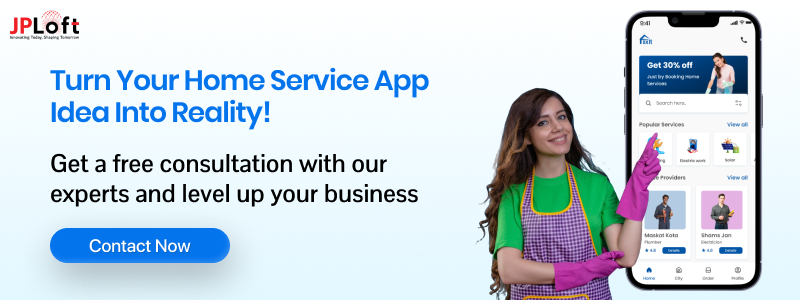






Share this blog